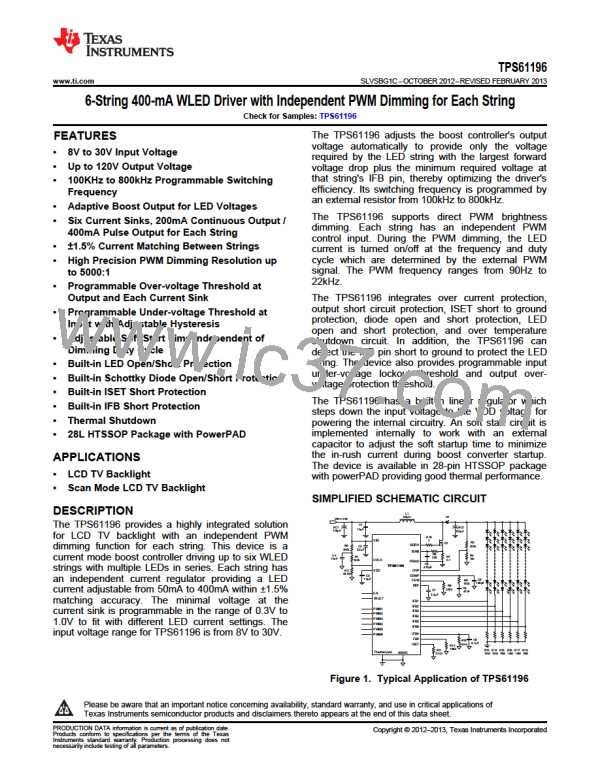TPS61196
www.ti.com
SLVSBG1C –OCTOBER 2012–REVISED FEBRUARY 2013
PWM Dimming
LED brightness dimming is set by applying an external PWM signal of 90Hz to 22kHz to the PWM pins. Each
LED string has an independent PWM input. Varying the PWM duty cycle from 0% to 100% adjusts the LED from
minimum to maximum brightness respectively. The recommended minimum on time of the LED string is 10µsec.
Thus the TPS61196 has a minimum dimming duty cycle of 500:1 at 200Hz.
When all PWM voltages are pulled low during dimming off, the TPS61196 turns off the LED strings and keeps
the boost converter running at PFM mode. The output voltage is kept at the level which is a little bit lower than
that when PWM is high. Thus, the TPS61196 limits the output ripple due to the load transient that occurs during
PWM dimming.
When all PWM voltages are pulled low for more than 20ms, to avoid the REF pin voltage dropping due to the
leakage current, the voltage of the REF pin is held by an internal reference voltage which equals to the REF pin
voltage in normal dimming operation. Thus the output voltage will be kept at the same level as the normal output
voltage.
Since the output voltage in long time dimming off status is almost the same as the normal voltage for turning the
LED on, the TPS61196 turns on the LED very fast without any flicker when recovering from long time dimming
off to small duty cycle dimming on.
Protections
The TPS61196 has full set of protections making the system safe to any abnormal conditions. Some protections
will latch the TPS61196 in off state until its power supply is recycled or it is disabled and then enabled again. In
latch off state, the REF pin voltage is discharged to 0V.
1. Switch current limit protection using the ISNS pin
The TPS61196 monitors the inductor current through the voltage across a sense resistor (R7 in the
SIMPLIFIED SCHEMATIC CIRCUIT) in order to provide current limit protection. During the switch FET on
period, when the voltage at the ISNS pin rises above 400 mV (VISNS in the ELECTRICAL
CHARACTERISTICS table), the TPS61196 turns off the FET immediately and does not turn it back on until
the next switch cycle. The switch current limit is equal to 400mV / R7.
2. LED open protection
When one of the LED strings is open, the voltage at the IFB pin connecting to this LED string drops to zero
during dimming-on time. The TPS61196 monitors the IFB voltage for 20ms. If the IFB voltage is still below
the threshold of 0.2V, the current sink is disabled and an internal pull-up current is activated to detect the IFB
voltage again. If the IFB voltage is pulled up to a high voltage, this LED string is recognized as LED open. As
a result, the TPS61196 deactivates the open IFB pin and removes it from the voltage feedback loop.
Afterwards, the output voltage returns to the voltage required for the connected LED strings. The IFB pin
currents of the connected strings remain in regulation during this process. If all the LED strings are open, the
TPS61196 is latched off.
3. LED short-cross protection using the FBP pin
If one or several LEDs short in one string, the corresponding IFB pin voltage rises but continues to sink the
LED current, causing increased IC power dissipation. To protect the IC, the TPS61196 provides a
programmable LED short-across protection feature by properly sizing the resistor on the FBP pin (R12 in the
SIMPLIFIED SCHEMATIC CIRCUIT) using Equation 5.
R12
VLED _ SHORT
=
´1.229V
(5)
If any IFB pin voltage exceeds the threshold (VLED_SHORT), the IC turns off the corresponding current sink and
removes this IFB pin from the output voltage regulation loop. Current regulation of the remaining IFB pins is
not affected.
4. Schottky diode open protection
When the TPS61196 is powered on, it checks the topology connection first. After the TPS61196 delays
400us, it checks the voltage at the OVP pin to see if the Schottky diode is not connected or the boost output
is hard-shorted to ground. If the voltage at the OVP pin is lower than 70mV, the TPS61196 is locked in off
state until the input power is recycled or it is enabled again.
5. Schottky diode short protection
Copyright © 2012–2013, Texas Instruments Incorporated
Submit Documentation Feedback
15
Product Folder Links :TPS61196

 TI [ TEXAS INSTRUMENTS ]
TI [ TEXAS INSTRUMENTS ]